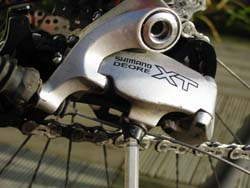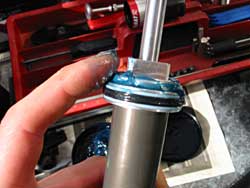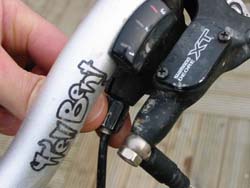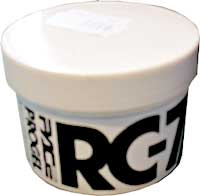These days most full suspension bikes are fairly reliable, but there’s one bit that regularly gives up the ghost – the shock bushings. You’re probably familiar with the symptoms – an irritating knocking noise from the back end, a distinct vertical looseness to the suspension… Nearly all rear shocks have pressed-in self-lubricating bushes running on aluminium spacers. It’s a sensible design assuming that all the loads are along the axis of the shock – any sideways slop in the rear suspension will put off-axis loads through there and lead to premature bushing failure. Some shocks have spherical bearings at the ends so that can handle a bit of wibble, but most don’t – if you’re getting through bushings at a prodigious rate check for slop elsewhere.
Assuming the thing’s just reached the end of its natural lifespan, we’ve always had the best results from replacing the bushing and the spacers all at once. Generally the low-friction coating has worn off the bushing and the spacers have become misshapen with wear. Do the lot and you’ll be back to a delightful factory-fresh tight rear…
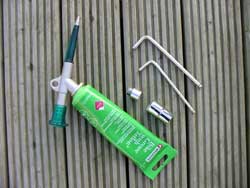 1. Tools, then. Exactly what you’ll need will vary a bit according to your bike, but Allen keys, grease and a selection of sockets will see you right.
1. Tools, then. Exactly what you’ll need will vary a bit according to your bike, but Allen keys, grease and a selection of sockets will see you right.
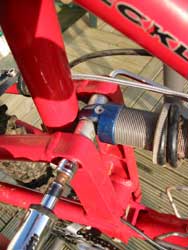 2. Before we can deal with the bushings we need to take the shock off. At each end there’ll either be a shaft with bolts threaded into each end or a big bolt that goes right through with a Nyloc nut on the other end. Shafts and bolts may need gently tapping through – it makes life a lot easier if you can support the weight of the back end so it’s not trying to pull the shock open as you remove the bolts.
2. Before we can deal with the bushings we need to take the shock off. At each end there’ll either be a shaft with bolts threaded into each end or a big bolt that goes right through with a Nyloc nut on the other end. Shafts and bolts may need gently tapping through – it makes life a lot easier if you can support the weight of the back end so it’s not trying to pull the shock open as you remove the bolts.
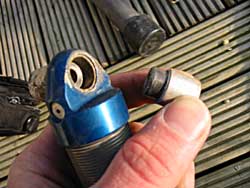 3. With the shock out, the alu spacers should be easily removed. They’re probably all blackened and nasty, but don’t chuck ’em just yet as they may well come in handy in a moment…
3. With the shock out, the alu spacers should be easily removed. They’re probably all blackened and nasty, but don’t chuck ’em just yet as they may well come in handy in a moment…
 4.Careful inspection of the bushing pushed into the shock eyelet should reveal that it’s ever so slightly over to one side. This gives you a toehold for the new bushing – you should be able to rest it on the end of the old one with the very end just inside the shock eyelet.
4.Careful inspection of the bushing pushed into the shock eyelet should reveal that it’s ever so slightly over to one side. This gives you a toehold for the new bushing – you should be able to rest it on the end of the old one with the very end just inside the shock eyelet.
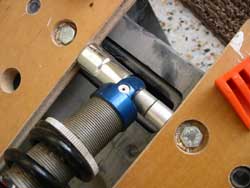 5.Place a suitably-sized socket or spacer over the opposite side of the shock eyelet (it needs to be big enough for the bushing to pass inside it) and one of the old alu spacers in the new bushing. Get the whole lot in a vice and gently squeeze. The new bushing should drive its way into the shock eye, pushing the old one out as it does so. It’s a proper tight fit but once it’s started it should slide in relatively easy. A proper big bench vice is a usefuly ally. In an ideal world the new bushing will be ever so slightly narrower than the shock eyelet so when it’s flush one side there’s a hint of a step on the other to give the next new bushing a start.
5.Place a suitably-sized socket or spacer over the opposite side of the shock eyelet (it needs to be big enough for the bushing to pass inside it) and one of the old alu spacers in the new bushing. Get the whole lot in a vice and gently squeeze. The new bushing should drive its way into the shock eye, pushing the old one out as it does so. It’s a proper tight fit but once it’s started it should slide in relatively easy. A proper big bench vice is a usefuly ally. In an ideal world the new bushing will be ever so slightly narrower than the shock eyelet so when it’s flush one side there’s a hint of a step on the other to give the next new bushing a start.
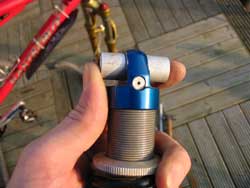 6.With a shiny new bushing in place, it’s time to push the new spacers in. We took the opportunity to replace the alu spacers with a mounting kit from TF Tuned Shox (BETD do a similar kit) that uses a steel shaft through the bushings with an alu spacer each side so that the bushing’s running on hard steel rather than soft alu. This should extend the life of the whole assembly considerably. Whichever you choose, it’ll be a snug fit at first and may need pressing or tapping in (or through). Don’t apply any grease or lube to the bushing surface – it’ll just cause the coating to break down and flake off.
6.With a shiny new bushing in place, it’s time to push the new spacers in. We took the opportunity to replace the alu spacers with a mounting kit from TF Tuned Shox (BETD do a similar kit) that uses a steel shaft through the bushings with an alu spacer each side so that the bushing’s running on hard steel rather than soft alu. This should extend the life of the whole assembly considerably. Whichever you choose, it’ll be a snug fit at first and may need pressing or tapping in (or through). Don’t apply any grease or lube to the bushing surface – it’ll just cause the coating to break down and flake off.
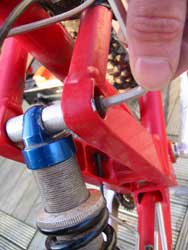 7.With everything back in place, remount the shock on the bike. A smear of grease on the mounting bolts or shafts will help everything slide back together easily. Do up the various bolts and you’re back to a world of non-rattly suspension happiness…
7.With everything back in place, remount the shock on the bike. A smear of grease on the mounting bolts or shafts will help everything slide back together easily. Do up the various bolts and you’re back to a world of non-rattly suspension happiness…

